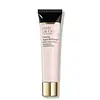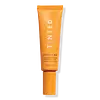What's inside
What's inside
 Key Ingredients
Key Ingredients

 Benefits
Benefits

 Concerns
Concerns

 Ingredients Side-by-side
Ingredients Side-by-side

Water
Skin ConditioningMethyl Trimethicone
Skin ConditioningButylene Glycol
HumectantGlycerin
HumectantGlycereth-26
HumectantPropanediol
SolventDimethicone
EmollientSodium Hyaluronate
HumectantTocopheryl Acetate
AntioxidantSqualane
EmollientHelianthus Annuus Seed Extract
Skin ConditioningPropylene Glycol Dicaprate
EmollientCucumis Sativus Fruit Extract
EmollientSimmondsia Chinensis Seed Oil
EmollientHaberlea Rhodopensis Leaf Extract
Skin ConditioningBeta Vulgaris Root Extract
Skin ConditioningPalmitoyl Tripeptide-1
Skin ConditioningArtemia Extract
Skin ConditioningNymphaea Alba Root Extract
Skin ConditioningHordeum Vulgare Extract
EmollientPolygala Senega Root Extract
RefreshingBeta Vulgaris Extract
Skin ProtectingCaffeine
Skin ConditioningPhenyl Trimethicone
Skin ConditioningAscorbyl Glucoside
AntioxidantBetaine
HumectantTrehalose
HumectantEthylhexyl Palmitate
EmollientCetyl PEG/PPG-10/1 Dimethicone
EmulsifyingLauryl PEG-9 Polydimethylsiloxyethyl Dimethicone
Skin ConditioningCholesterol
EmollientMethyldihydrojasmonate
MaskingMethicone
EmollientCaprylyl Glycol
EmollientTriticum Vulgare Germ Extract
Skin ConditioningYeast Extract
Skin ConditioningTribehenin
EmollientGlucose
HumectantSucrose
HumectantTin Oxide
AbrasiveDimethicone/PEG-10/15 Crosspolymer
Dipropylene Glycol
HumectantPEG-75
HumectantSilica Dimethyl Silylate
EmollientSorbitan Isostearate
EmulsifyingPolysilicone-11
Synthetic Fluorphlogopite
Xanthan Gum
EmulsifyingPolyquaternium-51
Skin ConditioningNylon-12
Citric Acid
BufferingSodium Chloride
MaskingDisodium EDTA
Sodium Citrate
BufferingChlorphenesin
AntimicrobialPotassium Sorbate
PreservativePhenoxyethanol
PreservativeMica
Cosmetic ColorantCI 77891
Cosmetic ColorantCI 77491
Cosmetic ColorantCI 77163
Cosmetic ColorantWater, Methyl Trimethicone, Butylene Glycol, Glycerin, Glycereth-26, Propanediol, Dimethicone, Sodium Hyaluronate, Tocopheryl Acetate, Squalane, Helianthus Annuus Seed Extract, Propylene Glycol Dicaprate, Cucumis Sativus Fruit Extract, Simmondsia Chinensis Seed Oil, Haberlea Rhodopensis Leaf Extract, Beta Vulgaris Root Extract, Palmitoyl Tripeptide-1, Artemia Extract, Nymphaea Alba Root Extract, Hordeum Vulgare Extract, Polygala Senega Root Extract, Beta Vulgaris Extract, Caffeine, Phenyl Trimethicone, Ascorbyl Glucoside, Betaine, Trehalose, Ethylhexyl Palmitate, Cetyl PEG/PPG-10/1 Dimethicone, Lauryl PEG-9 Polydimethylsiloxyethyl Dimethicone, Cholesterol, Methyldihydrojasmonate, Methicone, Caprylyl Glycol, Triticum Vulgare Germ Extract, Yeast Extract, Tribehenin, Glucose, Sucrose, Tin Oxide, Dimethicone/PEG-10/15 Crosspolymer, Dipropylene Glycol, PEG-75, Silica Dimethyl Silylate, Sorbitan Isostearate, Polysilicone-11, Synthetic Fluorphlogopite, Xanthan Gum, Polyquaternium-51, Nylon-12, Citric Acid, Sodium Chloride, Disodium EDTA, Sodium Citrate, Chlorphenesin, Potassium Sorbate, Phenoxyethanol, Mica, CI 77891, CI 77491, CI 77163
Zinc Oxide 18.23%
Cosmetic ColorantWater
Skin ConditioningCaprylic/Capric Triglyceride
MaskingC13-15 Alkane
SolventPropanediol
SolventC15-19 Alkane
SolventBis-Diglyceryl Polyacyladipate-2
EmollientTocopherol
AntioxidantOctyldodecanol
EmollientPolyhydroxystearic Acid
EmulsifyingInositol
HumectantHippophae Rhamnoides Oil
EmollientSilica
AbrasivePolyacrylate Crosspolymer-6
Emulsion StabilisingIsostearic Acid
CleansingLecithin
EmollientPolyglyceryl-3 Polyricinoleate
EmulsifyingXanthan Gum
EmulsifyingCoco-Glucoside
CleansingPolyglycerin-3
HumectantPolyglyceryl-3 Lactate/Laurate
CleansingBisabolol
MaskingCaprylhydroxamic Acid
Sodium Dilauramidoglutamide Lysine
HumectantSodium Citrate
BufferingCitric Acid
BufferingArachidyl Glucoside
EmulsifyingSodium Phytate
Glycerin
HumectantPhysalis Alkekengi Calyx Extract
Skin ConditioningBiosaccharide Gum-1
HumectantSodium Levulinate
Skin ConditioningGlyceryl Caprylate
EmollientCetearyl Alcohol
EmollientT-Butyl Alcohol
PerfumingSodium Anisate
AntimicrobialGlucose
HumectantBeta-Carotene
Skin ConditioningBehenyl Alcohol
EmollientArachidyl Alcohol
EmollientCI 77492
Cosmetic ColorantCI 77491
Cosmetic ColorantZinc Oxide 18.23%, Water, Caprylic/Capric Triglyceride, C13-15 Alkane, Propanediol, C15-19 Alkane, Bis-Diglyceryl Polyacyladipate-2, Tocopherol, Octyldodecanol, Polyhydroxystearic Acid, Inositol, Hippophae Rhamnoides Oil, Silica, Polyacrylate Crosspolymer-6, Isostearic Acid, Lecithin, Polyglyceryl-3 Polyricinoleate, Xanthan Gum, Coco-Glucoside, Polyglycerin-3, Polyglyceryl-3 Lactate/Laurate, Bisabolol, Caprylhydroxamic Acid, Sodium Dilauramidoglutamide Lysine, Sodium Citrate, Citric Acid, Arachidyl Glucoside, Sodium Phytate, Glycerin, Physalis Alkekengi Calyx Extract, Biosaccharide Gum-1, Sodium Levulinate, Glyceryl Caprylate, Cetearyl Alcohol, T-Butyl Alcohol, Sodium Anisate, Glucose, Beta-Carotene, Behenyl Alcohol, Arachidyl Alcohol, CI 77492, CI 77491
 Reviews
Reviews

Ingredients Explained
These ingredients are found in both products.
Ingredients higher up in an ingredient list are typically present in a larger amount.
Ci 77491 is also hydrated iron III oxide. It's sole purpose is to give a red/pink hue to products.
Iron III oxides are classified as inorganic chemicals for coloring.
Synthetically created Ci 77491 is considered safer than those naturally found. This is because the synthetically created version may contain less impurities. Iron oxides are generally non-toxic and non-allergenic.
Learn more about CI 77491Citric Acid is an alpha hydroxy acid (AHA) naturally found in citrus fruits like oranges, lemons, and limes.
Like other AHAs, citric acid can exfoliate skin by breaking down the bonds that hold dead skin cells together. This helps reveal smoother and brighter skin underneath.
However, this exfoliating effect only happens at high concentrations (20%) which can be hard to find in cosmetic products.
Due to this, citric acid is usually included in small amounts as a pH adjuster. This helps keep products slightly more acidic and compatible with skin's natural pH.
In skincare formulas, citric acid can:
While it can provide some skin benefits, research shows lactic acid and glycolic acid are generally more effective and less irritating exfoliants.
Most citric acid used in skincare today is made by fermenting sugars (usually from molasses). This synthetic version is identical to the natural citrus form but easier to stabilize and use in formulations.
Read more about some other popular AHA's here:
Learn more about Citric AcidGlucose is a simple sugar and is the most important source of energy in all organisms.
In skincare, glucose is used to hydrate the skin. It also acts as a prebiotic for our natural biome.
Glucose is hydrating due to its humectant property. As a humectant, glucose draws moisture from the air and from deeper levels in the skin.
Our skin contains many sugars that act as prebiotics and help strengthen our natural microbiome. Having a healthy microbiome helps protect our skin from harmful bacteria and other contaminants.
Studies show glucose may help with fading discoloration and pigmentation. This is because our skin metabolizes glucose into lactic acid. Lactic acid is an AHA that helps exfoliate the top layer of skin.
Learn more about GlucoseGlycerin is already naturally found in your skin. It helps moisturize and protect your skin.
A study from 2016 found glycerin to be more effective as a humectant than AHAs and hyaluronic acid.
As a humectant, it helps the skin stay hydrated by pulling moisture to your skin. The low molecular weight of glycerin allows it to pull moisture into the deeper layers of your skin.
Hydrated skin improves your skin barrier; Your skin barrier helps protect against irritants and bacteria.
Glycerin has also been found to have antimicrobial and antiviral properties. Due to these properties, glycerin is often used in wound and burn treatments.
In cosmetics, glycerin is usually derived from plants such as soybean or palm. However, it can also be sourced from animals, such as tallow or animal fat.
This ingredient is organic, colorless, odorless, and non-toxic.
Glycerin is the name for this ingredient in American English. British English uses Glycerol/Glycerine.
Learn more about GlycerinPropanediol is an all-star ingredient. It softens, hydrates, and smooths the skin.
It’s often used to:
Propanediol is not likely to cause sensitivity and considered safe to use. It is derived from corn or petroleum with a clear color and no scent.
Learn more about PropanediolSodium Citrate is the sodium salts of citric acid. In skincare, it is used to alter pH levels and acts as a preservative.
Its main functions are to maintain the pH of a product and neutralize metal ions.
The acidity of our skin is maintained by our glands and skin biome; normal pH level of skin is slightly acidic (~4.75-5.5).
Being slightly acidic allows our skin to create an "acid mantle". This acid mantle is a thin barrier that protects our skin from bacteria and contaminants.
Learn more about Sodium CitrateWater. It's the most common cosmetic ingredient of all. You'll usually see it at the top of ingredient lists, meaning that it makes up the largest part of the product.
So why is it so popular? Water most often acts as a solvent - this means that it helps dissolve other ingredients into the formulation.
You'll also recognize water as that liquid we all need to stay alive. If you see this, drink a glass of water. Stay hydrated!
Learn more about WaterXanthan gum is used as a stabilizer and thickener within cosmetic products. It helps give products a sticky, thick feeling - preventing them from being too runny.
On the technical side of things, xanthan gum is a polysaccharide - a combination consisting of multiple sugar molecules bonded together.
Xanthan gum is a pretty common and great ingredient. It is a natural, non-toxic, non-irritating ingredient that is also commonly used in food products.
Learn more about Xanthan Gum